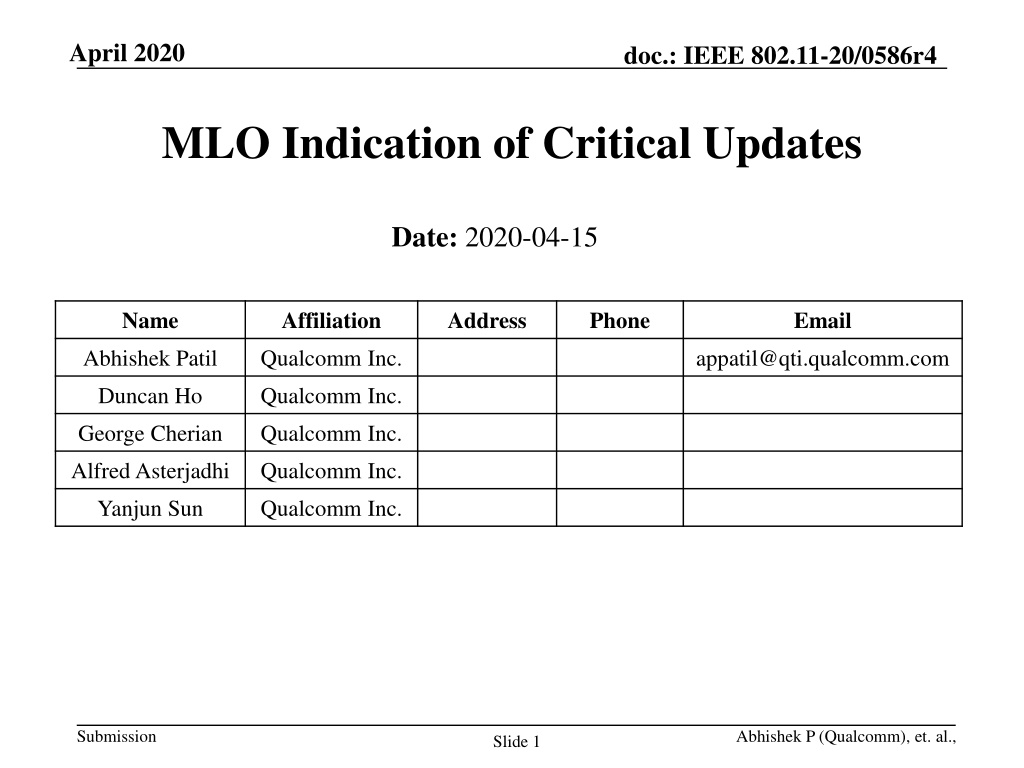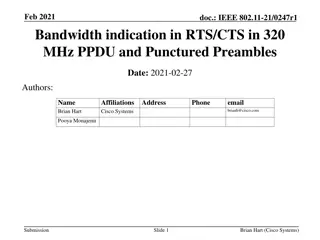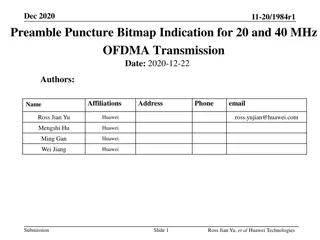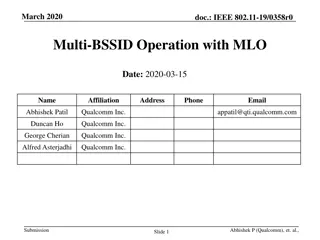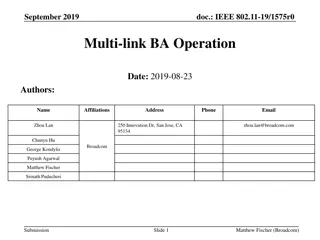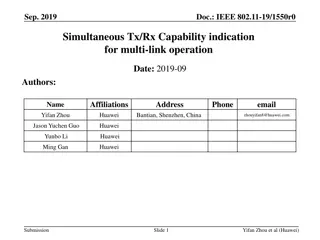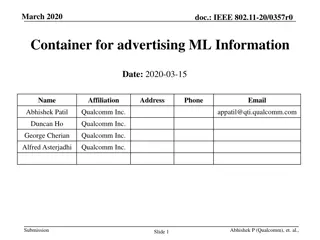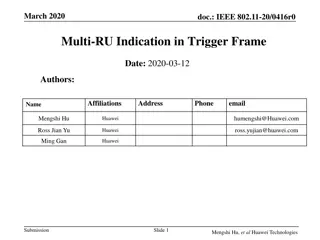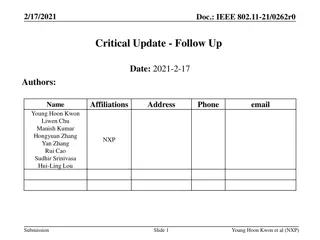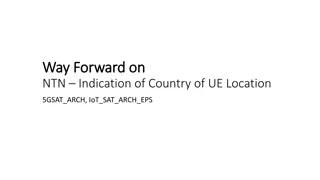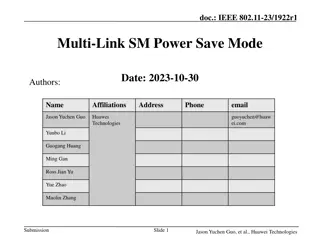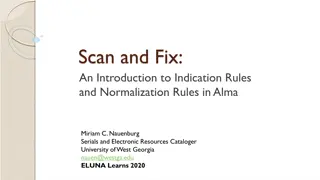IEEE 802.11-20/0586r4 MLO Indication of Critical Updates
The document discusses the need for a mechanism in the MLO framework to enable non-AP MLDs to receive updates to operational parameters without monitoring all links. It proposes that each AP of an MLD should provide an indication of updates to another AP's operational parameters. It also outlines how an AP's beacon includes a sequence counter for critical operational parameter changes and explains the process for retrieving updated parameters by non-AP MLDs. This solution aims to streamline update notifications and power conservation in WLAN setups.
Download Presentation

Please find below an Image/Link to download the presentation.
The content on the website is provided AS IS for your information and personal use only. It may not be sold, licensed, or shared on other websites without obtaining consent from the author. Download presentation by click this link. If you encounter any issues during the download, it is possible that the publisher has removed the file from their server.
E N D
Presentation Transcript
April 2020 doc.: IEEE 802.11-20/0586r4 MLO Indication of Critical Updates Date: 2020-04-15 Name Affiliation Address Phone Email Abhishek Patil Qualcomm Inc. appatil@qti.qualcomm.com Duncan Ho Qualcomm Inc. George Cherian Qualcomm Inc. Alfred Asterjadhi Qualcomm Inc. Yanjun Sun Qualcomm Inc. Submission Abhishek P (Qualcomm), et. al., Slide 1
April 2020 doc.: IEEE 802.11-20/0586r4 Problem statement A non-AP MLD can conserve power by performing basic BSS operations on a single link [1, 2, 3, 4] MLO framework needs to provide a mechanism that would enable a non-AP MLD to receive updates to the operational parameter(s) for any link of the AP MLD without requiring the non-AP MLD to monitor all links Further any update that requires STA to not transmit on a link must be notified immediately. Submission Slide 2 Abhishek P (Qualcomm), et. al.,
April 2020 doc.: IEEE 802.11-20/0586r4 Solution Summary Each AP of an MLD provides an indication of an update to the operational parameter(s) of another AP of the MLD Any update that requires silencing of STAs in the reported BSS is explicitly notified on the reporting link Submission Slide 3 Abhishek P (Qualcomm), et. al.,
April 2020 doc.: IEEE 802.11-20/0586r4 Indication of an update An AP s beacon includes a sequence counter affiliated with its current BSS parameter The counter is incremented whenever there is a change to one or more critical operational parameters. Further, the link information contained in the beacon transmitted by an AP of an MLD carries the most recent value of sequence counter for a reported AP Advertising a counter instead of actual element(s) helps keep the beacon size small Updates to operational parameters such as channel change announcements (CSA, ECSA), (V)HT/HE/EHT Op, (MU-)EDCA parameters, OM notifications etc qualify as critical updates Sequence counter similar to the Check Beacon field in TIM frame (See 11.2.3.15) For example when AP makes a channel change announcement (by including ECSA element), it increments the sequence counter for its BSS. Other APs of the MLD advertise the new value of sequence counter Slide 4 Submission Abhishek P (Qualcomm), et. al.,
April 2020 doc.: IEEE 802.11-20/0586r4 Retrieving updated parameters Non-AP MLD maintains a record of the most recently received sequence counter for each set-up link A STA of a non-AP MLD can probe the reporting AP to retrieve updated parameters for the reported AP Benefit: non-AP MLD is not required to wake-up the STA on the reported link Works in situations where the BSS on the other link is in silence mode see next slide AP is recommended to transmit a broadcast Probe Response frame, carrying the profile for the requested link, in response to such a probe request Currently allowed (11ai/11ax) Helps address Probe storm issue i.e., prevents probe request from multiple STAs to retrieve the update Submission Slide 5 Abhishek P (Qualcomm), et. al.,
April 2020 doc.: IEEE 802.11-20/0586r4 Do-not-transmit indication An AP may announce silence time on its BSS e.g., Quiet element or Channel Switch Mode=1 In such case, the counter-based indication is not sufficient Non-AP STA MLD must be told right-away that it should not transmit any frames on the silenced channel For such cases, other APs of the MLD provide an explicit do- not-transmit (DNT) notification on behalf of the silencing AP This is achieved by means for a single DNT bit in the per-link profile Non-AP MLD is required to not transmit any frames on a link for which the AP MLD has indicated silence Submission Slide 6 Abhishek P (Qualcomm), et. al.,
April 2020 doc.: IEEE 802.11-20/0586r4 Signaling of critical updates CSN=26 CSN=26 CSN=25 CSN=26 MLA IE [Link 2 (CSN=45, DNT=0)] MLA IE [Link 2 (CSN=45, DNT=0)] MLA IE [Link 2 (CSN=45, DNT=0)] MLA IE [Link 2 (CSN=45, DNT=0)] ECSA IE [(mode=1)] ECSA IE [(mode=1)] ... AP1 of AP MLD Link 1 Beacon Beacon Beacon Beacon Non-STA 1 in doze state ... Non-AP STA1 of non-AP MLD CSN=45 CSN=45 CSN=45 CSN=45 MLA IE [Link 1 (CSN=26, DNT=1)] MLA IE [Link 1 (CSN=25, DNT=0)] MLA IE [Link 1 (CSN=26, DNT=1)] MLA IE [Link 1 (CSN=26, DNT=0)] MLA IE [Link 1(ECSA IE [(mode=1)])] ... AP2 of AP MLD (broadcast) Probe Resp Beacon Beacon Beacon Beacon Link 2 ... Non-AP STA2 of non-AP MLD Probe Req Submission Slide 7 Abhishek P (Qualcomm), et. al.,
April 2020 doc.: IEEE 802.11-20/0586r4 Summary This contribution provides a mechanism by which a non-AP MLD can gather critical updates for any link of an AP MLD without requiring to monitor each link. Proposes to add a bit to signal silencing of a reported AP Proposes to define a sequence counter affiliated with critical parameters for each AP of an MLD The counter is carried in an AP s Beacon frame and incremented each time there is an update to critical parameter set. The counter value is also advertised by other APs of the MLD Aids power-save by enabling a non-AP MLD retrieve BSS parameter updates of any AP of the MLD on the link where the non-AP is performing basic BSS operation Submission Slide 8 Abhishek P (Qualcomm), et. al.,
April 2020 doc.: IEEE 802.11-20/0586r4 SP #1 Do you agree that an AP of an AP MLD shall signal a do-not-transmit (DNT) bit affiliated with another AP of its MLD to indicate that the BSS of the reported AP is in silence mode (i.e., no transmissions are permitted on the channel where the reported AP resides). Y: N: A: Submission Slide 9 Abhishek P (Qualcomm), et. al.,
April 2020 doc.: IEEE 802.11-20/0586r4 SP #2 Amend SP #77 Do you agree that a beacon transmitted by an AP of an AP MLD shall carry a change sequence counter (CSN) field whose value is associated with critical parameters for the AP s BSS and the value is incremented by 1 each time there is an update to the critical parameters? Note 1: The name, size, and signaling of the sequence counter is TBD. Note 2: The sequence counter is initialized to 0 and the value is modulo of the maximum value carried in the field Note 3: The critical parameter are defined in 11.2.3.15 Note 4: 802.11be amendment may make updates to the critical parameters list in 11.2.3.15 Y: N: A: Submission Slide 10 Abhishek P (Qualcomm), et. al.,
April 2020 doc.: IEEE 802.11-20/0586r4 SP #2 Do you agree to amend SP #77 as following: Do you support that an AP within an AP MLD shall include in the Beacon and Probe Response frames it transmits the Change Sequence fields that indicate changes of system information for the transmitting AP and other APs within the same AP MLD, where the change sequence field value for the reported each AP is initialized to 0, and is that increments incremented when there is a as the critical update to the operational parameters for that of the reported AP is occurred? The EHT Operation element shall include a field to carry change sequence Information of the transmitting AP The signaling of the Change Sequence field for other AP(s) is TBD. The critical updates are defined in 11.2.3.15 TIM Broadcast and the additional update can be added if needed. The field is 1 octet in length and the value carried in the field is modulo of the maximum value (255) Y: N: A: TGbe editor: Please replace SP #77 with the above SP text for motion Submission Slide 11 Abhishek P (Qualcomm), et. al.,
April 2020 doc.: IEEE 802.11-20/0586r4 SP #3 Do you agree that the AP of an AP MLD shall advertise a change sequence counter (CSN) field affiliated with another AP of its MLD and the value of the field shall be the same as the change sequence counter (CSN) field carried in the beacon of the reported AP. Note: The name, size, and signaling of the sequence counter is TBD. Y: N: A: Submission Slide 12 Abhishek P (Qualcomm), et. al.,
April 2020 doc.: IEEE 802.11-20/0586r4 SP #4 Do you agree that a non-AP MLD that has performed ML setup with an AP MLD shall acquire the most recent BSS parameters for an AP of that AP MLD before the non-AP MLD s STA on that link transmits a frame on that link? Y: N: A: Submission Slide 13 Abhishek P (Qualcomm), et. al.,
April 2020 doc.: IEEE 802.11-20/0586r4 SP #5 Do you agree that a STA of a non-AP MLD may send an individually addressed Probe Request frame to the peer AP on its link, to gather updates to the operational parameter(s) of another AP of the AP MLD with which the non-AP MLD has setup ML setup. Y: N: A: Submission Slide 14 Abhishek P (Qualcomm), et. al.,
April 2020 doc.: IEEE 802.11-20/0586r4 SP #6 Do you agree that an AP of an AP MLD should send a broadcast Probe Response frame in response to a Probe Request frame requesting information of another AP of the AP MLD when the request frame is received from a STA of a non-AP MLD with which the AP MLD has performed ML setup? Y: N: A: Submission Slide 15 Abhishek P (Qualcomm), et. al.,
April 2020 doc.: IEEE 802.11-20/0586r4 APPENDIX Submission Slide 16 Abhishek P (Qualcomm), et. al.,
April 2020 doc.: IEEE 802.11-20/0586r4 References [1]: 11-19-1526 Multi-link Power-save (Abhishek, Qualcomm) [2]: 11-20/070 Multi-link power saving operation (Yonggang, ZTE) [3]: 11-19/1988 Power Save for Multi-link (Ming, Huawei) [4]: 11-20/370 Multi-link Power Save Discussion (Sharan, Samsung) [5]: 11-20-0357 MLO: Container Structure for Capability Advertisement (Abhishek, Qualcomm) Submission Slide 17 Abhishek P (Qualcomm), et. al.,
